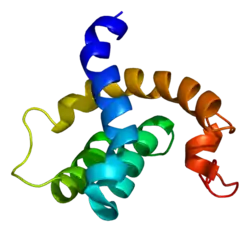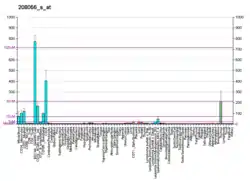CBFA2T3
Protein CBFA2T3 (core-binding factor, runt domain, alpha subunit 2; translocated to, 3) is a protein that in humans is encoded by the CBFA2T3 gene.[5][6]
Function
The t(16;21)(q24;q22) translocation is a rare but recurrent chromosomal abnormality associated with therapy-related myeloid malignancies. The translocation produces a chimeric gene made up of the 5'-region of the AML1 gene fused to the 3'-region of this gene. In addition, this gene is a putative breast tumor suppressor. Two transcript variants encoding different isoforms have been found for this gene, and a brefeldin A-sensitive association of RII-alpha protein with one of the isoforms has been demonstrated in the Golgi apparatus.[6]
Interactions
CBFA2T3 has been shown to interact with:
References
- GRCh38: Ensembl release 89: ENSG00000129993 - Ensembl, May 2017
- GRCm38: Ensembl release 89: ENSMUSG00000006362 - Ensembl, May 2017
- "Human PubMed Reference:". National Center for Biotechnology Information, U.S. National Library of Medicine.
- "Mouse PubMed Reference:". National Center for Biotechnology Information, U.S. National Library of Medicine.
- Calabi F, Cilli V (Dec 1998). "CBFA2T1 (core-binding factor, runt domain, alpha subunit 2; translocated to, 3), a gene rearranged in human leukemia, is a member of a multigene family". Genomics. 52 (3): 332–41. doi:10.1006/geno.1998.5429. PMID 9790752.
- "Entrez Gene: CBFA2T3 core-binding factor, runt domain, alpha subunit 2; translocated to, 3".
- Hoogeveen AT, Rossetti S, Stoyanova V, Schonkeren J, Fenaroli A, Schiaffonati L, van Unen L, Sacchi N (Sep 2002). "The transcriptional corepressor MTG16a contains a novel nucleolar targeting sequence deranged in t (16; 21)-positive myeloid malignancies". Oncogene. 21 (43): 6703–12. doi:10.1038/sj.onc.1205882. PMID 12242670.
- Amann JM, Nip J, Strom DK, Lutterbach B, Harada H, Lenny N, Downing JR, Meyers S, Hiebert SW (Oct 2001). "ETO, a target of t(8;21) in acute leukemia, makes distinct contacts with multiple histone deacetylases and binds mSin3A through its oligomerization domain". Mol. Cell. Biol. 21 (19): 6470–83. doi:10.1128/mcb.21.19.6470-6483.2001. PMC 99794. PMID 11533236.
- Goardon N, Lambert JA, Rodriguez P, Nissaire P, Herblot S, Thibault P, Dumenil D, Strouboulis J, Romeo PH, Hoang T (Jan 2006). "ETO2 coordinates cellular proliferation and differentiation during erythropoiesis". EMBO J. 25 (2): 357–66. doi:10.1038/sj.emboj.7600934. PMC 1383517. PMID 16407974.
- Schillace RV, Andrews SF, Liberty GA, Davey MP, Carr DW (Feb 2002). "Identification and characterization of myeloid translocation gene 16b as a novel a kinase anchoring protein in T lymphocytes". J. Immunol. 168 (4): 1590–9. doi:10.4049/jimmunol.168.4.1590. PMID 11823486.
- Lindberg SR, Olsson A, Persson AM, Olsson I (Dec 2003). "Interactions between the leukaemia-associated ETO homologues of nuclear repressor proteins". Eur. J. Haematol. 71 (6): 439–47. doi:10.1046/j.0902-4441.2003.00166.x. PMID 14703694. S2CID 23106882.
Further reading
- Kitabayashi I, Ida K, Morohoshi F, Yokoyama A, Mitsuhashi N, Shimizu K, Nomura N, Hayashi Y, Ohki M (1998). "The AML1-MTG8 leukemic fusion protein forms a complex with a novel member of the MTG8(ETO/CDR) family, MTGR1". Mol. Cell. Biol. 18 (2): 846–58. doi:10.1128/MCB.18.2.846. PMC 108796. PMID 9447981.
- Gamou T, Kitamura E, Hosoda F, Shimizu K, Shinohara K, Hayashi Y, Nagase T, Yokoyama Y, Ohki M (1998). "The partner gene of AML1 in t(16;21) myeloid malignancies is a novel member of the MTG8(ETO) family". Blood. 91 (11): 4028–37. doi:10.1182/blood.V91.11.4028. PMID 9596646.
- Schillace RV, Andrews SF, Liberty GA, Davey MP, Carr DW (2002). "Identification and characterization of myeloid translocation gene 16b as a novel a kinase anchoring protein in T lymphocytes". J. Immunol. 168 (4): 1590–9. doi:10.4049/jimmunol.168.4.1590. PMID 11823486.
- Kondoh K, Nakata Y, Furuta T, Hosoda F, Gamou T, Kurosawa Y, Kinoshita A, Ohki M, Tomita Y, Mori T (2003). "A pediatric case of secondary leukemia associated with t(16;21)(q24;q22) exhibiting the chimeric AML1-MTG16 gene". Leuk. Lymphoma. 43 (2): 415–20. doi:10.1080/10428190290006242. PMID 11999578. S2CID 23133496.
- Kochetkova M, McKenzie OL, Bais AJ, Martin JM, Secker GA, Seshadri R, Powell JA, Hinze SJ, Gardner AE, Spendlove HE, O'Callaghan NJ, Cleton-Jansen AM, Cornelisse C, Whitmore SA, Crawford J, Kremmidiotis G, Sutherland GR, Callen DF (2002). "CBFA2T3 (MTG16) is a putative breast tumor suppressor gene from the breast cancer loss of heterozygosity region at 16q24.3". Cancer Res. 62 (16): 4599–604. PMID 12183414.
- Powell JA, Gardner AE, Bais AJ, Hinze SJ, Baker E, Whitmore S, Crawford J, Kochetkova M, Spendlove HE, Doggett NA, Sutherland GR, Callen DF, Kremmidiotis G (2003). "Sequencing, transcript identification, and quantitative gene expression profiling in the breast cancer loss of heterozygosity region 16q24.3 reveal three potential tumor-suppressor genes". Genomics. 80 (3): 303–10. doi:10.1006/geno.2002.6828. PMID 12213200.
- Hoogeveen AT, Rossetti S, Stoyanova V, Schonkeren J, Fenaroli A, Schiaffonati L, van Unen L, Sacchi N (2002). "The transcriptional corepressor MTG16a contains a novel nucleolar targeting sequence deranged in t (16; 21)-positive myeloid malignancies". Oncogene. 21 (43): 6703–12. doi:10.1038/sj.onc.1205882. PMID 12242670.
- Lindberg SR, Olsson A, Persson AM, Olsson I (2004). "Interactions between the leukaemia-associated ETO homologues of nuclear repressor proteins". Eur. J. Haematol. 71 (6): 439–47. doi:10.1046/j.0902-4441.2003.00166.x. PMID 14703694. S2CID 23106882.
- Ibañez V, Sharma A, Buonamici S, Verma A, Kalakonda S, Wang J, Kadkol S, Saunthararajah Y (2004). "AML1-ETO decreases ETO-2 (MTG16) interactions with nuclear receptor corepressor, an effect that impairs granulocyte differentiation". Cancer Res. 64 (13): 4547–54. doi:10.1158/0008-5472.CAN-03-3689. PMID 15231665.
- Kumar R, Manning J, Spendlove HE, Kremmidiotis G, McKirdy R, Lee J, Millband DN, Cheney KM, Stampfer MR, Dwivedi PP, Morris HA, Callen DF (2006). "ZNF652, a novel zinc finger protein, interacts with the putative breast tumor suppressor CBFA2T3 to repress transcription". Mol. Cancer Res. 4 (9): 655–65. doi:10.1158/1541-7786.MCR-05-0249. PMID 16966434.
External links
- CBFA2T3+protein,+human at the US National Library of Medicine Medical Subject Headings (MeSH)
- Human CBFA2T3 genome location and CBFA2T3 gene details page in the UCSC Genome Browser.
This article incorporates text from the United States National Library of Medicine, which is in the public domain.






